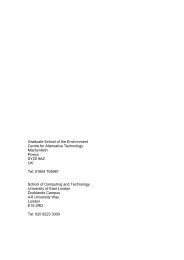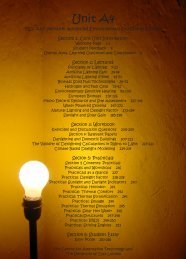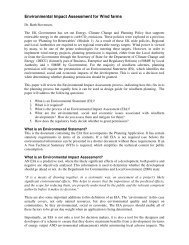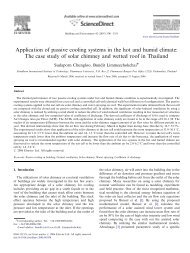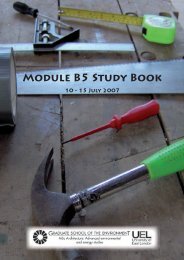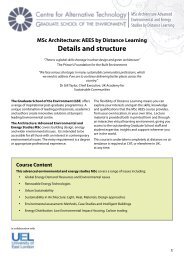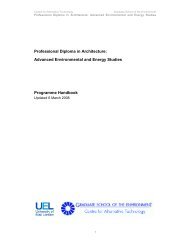Module B1 Study Book - the Graduate School of the Environment
Module B1 Study Book - the Graduate School of the Environment
Module B1 Study Book - the Graduate School of the Environment
Create successful ePaper yourself
Turn your PDF publications into a flip-book with our unique Google optimized e-Paper software.
) The economics <strong>of</strong> nuclear have been difficult to support, and <strong>the</strong> costs are<br />
increased by <strong>the</strong> extra safety measures are required to satisfy <strong>the</strong> political<br />
objections.<br />
The main problem is not so much <strong>the</strong> cost <strong>of</strong> <strong>the</strong> fuel [though reprocessing,<br />
if it relied on, adds to <strong>the</strong> cost substantially] but <strong>the</strong> cost <strong>of</strong> <strong>the</strong> plant. LWR<br />
plants cost in <strong>the</strong> range $1700 - 3100 / kW, (WEA 2000) around three times<br />
that <strong>of</strong> fossil fuel plants, and cost problems are exacerbated by construction<br />
delays and budget overruns.<br />
Newer generations <strong>of</strong> plants, it is claimed, will be cheaper [a recent US govt<br />
study put <strong>the</strong>m at a little over $2000 / kW], but we can build coal plants for a<br />
little over $1000, and gas for $500 (EIA, 2000). Operational costs have risen<br />
fast - largely because <strong>of</strong> safety fears - and stand at around three times those<br />
<strong>of</strong> fossil fuel plants (WEA, 2000). Meanwhile, <strong>the</strong> cost <strong>of</strong> fossil fuel electricity<br />
- coal to an extent, and much more so gas - has fallen substantially.<br />
In 1990, when <strong>the</strong> Thatcher government began <strong>the</strong> process <strong>of</strong> privatising<br />
<strong>the</strong> power industry, <strong>the</strong> City reacted badly. Under <strong>the</strong> old CEGB [Central<br />
Electricity Generating Board], <strong>the</strong>re had been massive subsidies, protection<br />
from competition and some extremely dodgy accounting. This latter had<br />
understated <strong>the</strong> costs, especially in insuring against accidents, in providing<br />
for decommissioning and waste disposal, and in pricing new investment.<br />
Ano<strong>the</strong>r fundamental problem was that <strong>the</strong> government applied a ‘test<br />
discount rate’ <strong>of</strong> 5%: this in effect meant that a much lower rate <strong>of</strong> return<br />
was acceptable, and so prices notionally ‘charged’ [it was all internal trading]<br />
could be lower. Lord Marshall, a nuclear enthusiast, warned that costs per<br />
kWh from PWRs would virtually double, from an already high 3.22p.<br />
The result <strong>of</strong> exposing <strong>the</strong> industry to <strong>the</strong> market was that, while nuclear had<br />
been made to look quite cheap [though in fact governments for some time,<br />
knowing something <strong>of</strong> <strong>the</strong> truth, had cooled a lot on new build <strong>of</strong> nuclear<br />
plant], it became clear that no company was going to invest in building<br />
nuclear with entirely its own shareholders’ money. Subsidies to <strong>the</strong> [now<br />
partly privatised] industry have continued at many hundreds <strong>of</strong> millions per<br />
year, and extremely large one-<strong>of</strong>f payments have also been necessary to<br />
keep <strong>the</strong> main players afloat.<br />
5. The arguments over nuclear power<br />
a) Can it be a big help in cutting CO2 emissions?<br />
Part <strong>of</strong> <strong>the</strong> anti-nuclear case is that it is not true that generating electricity<br />
from nuclear produces no CO2. The energy for plant construction, for mining,<br />
processing and fabrication <strong>of</strong> materials, and for reprocessing, are all energyintensive<br />
activities, and to <strong>the</strong> extent that this comes from fossil fuels, it is a<br />
source <strong>of</strong> CO2.<br />
Estimates <strong>of</strong> <strong>the</strong> life-cycle output <strong>of</strong> CO2 per kWh from any power station,<br />
and especially nuclear, are fraught with problems arising from <strong>the</strong> sensitivity<br />
<strong>of</strong> <strong>the</strong> calculation to assumptions about operational life and about <strong>the</strong> CO2<br />
Lecture: Nuclear Power 53




